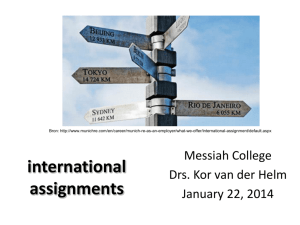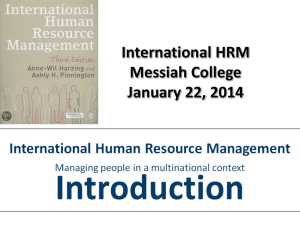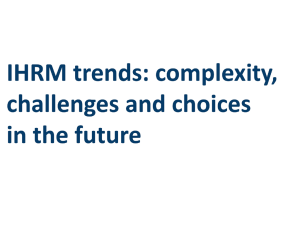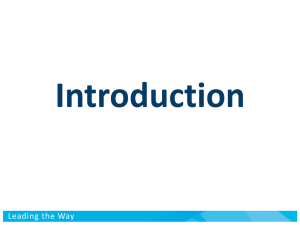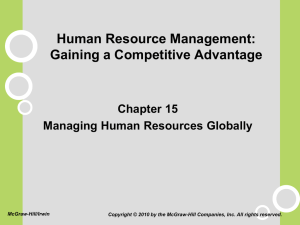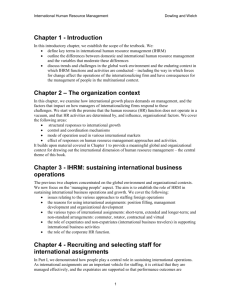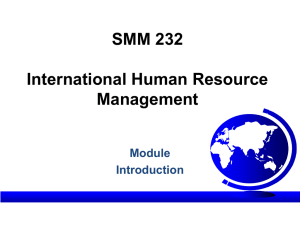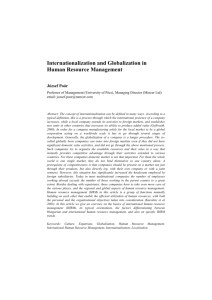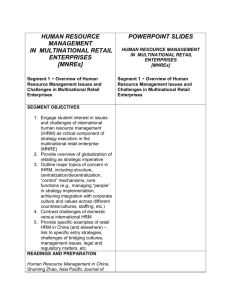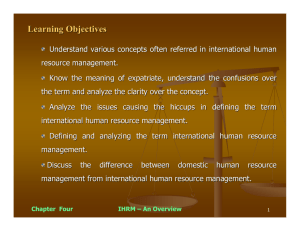international human resource management
advertisement
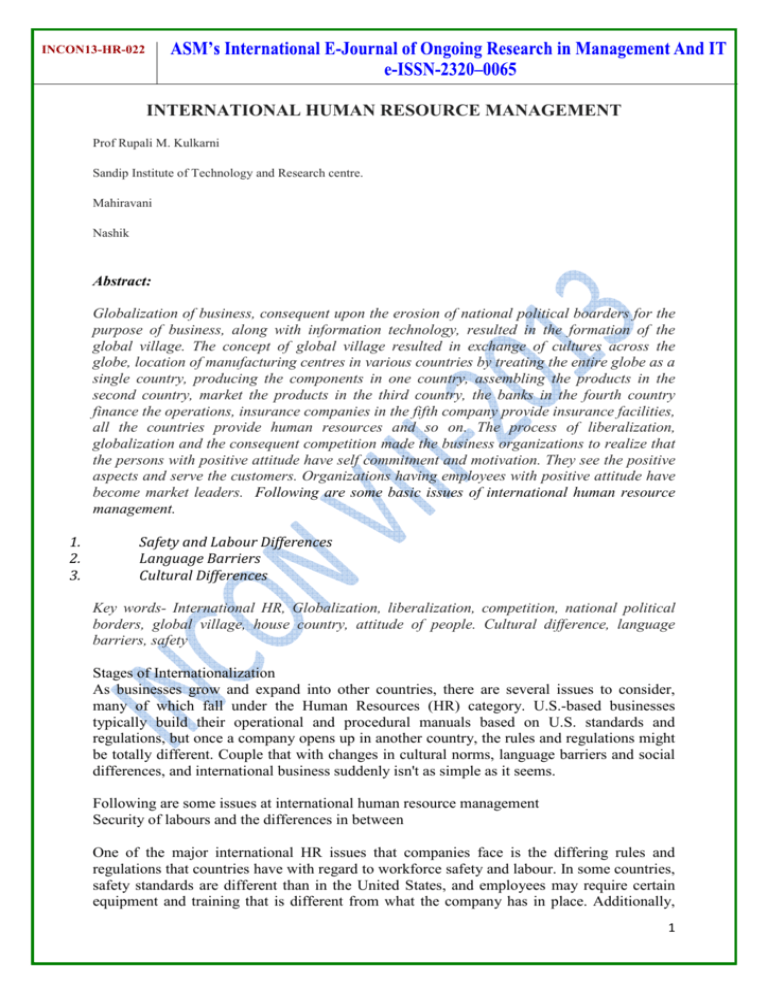
INCON13-HR-022 INTERNATIONAL HUMAN RESOURCE MANAGEMENT Prof Rupali M. Kulkarni Sandip Institute of Technology and Research centre. Mahiravani Nashik Abstract: Globalization of business, consequent upon the erosion of national political boarders for the purpose of business, along with information technology, resulted in the formation of the global village. The concept of global village resulted in exchange of cultures across the globe, location of manufacturing centres in various countries by treating the entire globe as a single country, producing the components in one country, assembling the products in the second country, market the products in the third country, the banks in the fourth country finance the operations, insurance companies in the fifth company provide insurance facilities, all the countries provide human resources and so on. The process of liberalization, globalization and the consequent competition made the business organizations to realize that the persons with positive attitude have self commitment and motivation. They see the positive aspects and serve the customers. Organizations having employees with positive attitude have become market leaders. Following are some basic issues of international human resource management. 1. 2. 3. Safety and Labour Differences Language Barriers Cultural Differences Key words- International HR, Globalization, liberalization, competition, national political borders, global village, house country, attitude of people. Cultural difference, language barriers, safety Stages of Internationalization As businesses grow and expand into other countries, there are several issues to consider, many of which fall under the Human Resources (HR) category. U.S.-based businesses typically build their operational and procedural manuals based on U.S. standards and regulations, but once a company opens up in another country, the rules and regulations might be totally different. Couple that with changes in cultural norms, language barriers and social differences, and international business suddenly isn't as simple as it seems. Following are some issues at international human resource management Security of labours and the differences in between One of the major international HR issues that companies face is the differing rules and regulations that countries have with regard to workforce safety and labour. In some countries, safety standards are different than in the United States, and employees may require certain equipment and training that is different from what the company has in place. Additionally, 1 INCON13-HR-022 workers' protections vary greatly from country to country. For instance, in Germany, asking employees to participate in a survey, a common U.S. business practice can be against local labour laws. Linguistic Barriers between employees One main issue facing international HR departments is the language barrier between the countries, workforce and overseas employees. Often times, the mistake that companies make is to simply translate particular country. Employee materials, thinking that they will apply to audiences worldwide. International HR teams need to consider "localization" when communicating to international employees. Everywhere in the whole globe varieties of languages are speaking. The employee who is going to be transfer or getting out side job find a severe problem of language. Employee communications that are filled with U.S. analogies, such as football or references to U.S. culture, won't make sense outside of U.S. borders. To better communicate with your international audience, you must get to know what makes sense to them. Cultural Differences Culture is very important aspects as far as organizational behaviour is concern. Culture has a great impact on person’s behaviour. Employee is carrying his attitude everywhere. In attitude cultures contribution matters a lot. In addition to language barriers, international HR teams must consider cultural differences and how to address them. In certain countries, such as those in Latin America, it is still relatively uncommon for women to be in high-ranking positions. This may make it difficult for a female executive to gain the trust of the employees there. It's important to discuss openly with employees the fact that in the United States, discrimination is illegal. Additionally, it may be common in some countries for officials to accept gifts and gratuities in exchange for favourable business workings. Since U.S. businesses are accountable to U.S. law no matter where they operate, extensive business ethics training might be required in some international locations. 1. Companies will continue to become larger with greater global footprints. The importance of globalization and successfully integrating markets across borders will be of critical importance. Underpinning this will be a natural conflict of allegiances pitting nationalism versus corporate success. What role will HR play in helping businesses balance national interests that me be in conflict with corporate goals? Like never before HR needs to be aware of changing political dynamics and landscapes. Will employees put country before company, and if so, what is your plan? 2. What functions within organizations will become increasingly critical, and how will those responsible identify, and secure the appropriate talent? As currency fluctuations increase in frequency and volatility, will your CFO’s be equipped with the optimal internal tax and treasury talent required to navigate and leverage exchanges? Are you prepared to deliver to them a contingency staffing plan that supports the elimination of the Euro and the introduction of independent currencies from across the European Union? That’s just the finance function. 3. We’re living in an increasingly border-less world in which talent management could take on a different meaning. Finding and retaining quality talent will continue to be essential to business sustainability, and most industries and countries will experience a widening talent gap for highly skilled jobs and the next generation of mid and senior leaders. Are you working with the state department and immigration attorneys here and abroad to ensure you 2 INCON13-HR-022 are leveraging the right resources to both push and pull international talent? Are you doing the same with executive search firms, and keeping a close eye on competitor’s activities? Who is applying for access and permits, and why and where? HR must become more externally focused and curious, providing insightful strategic information that can be applied quickly and effectively. 4. To survive large European and domestic unions need to evolve. There are two types of European councils, those centred on global companies; transnational works councils, and those centered upon industries; Global Union Federations. European works council arrangements have not proven to be as powerful or effective as a means of driving wage equity across borders. There’s been no wage bargaining transnational, even with the common currency of the Euro, although some have been able to bargain successfully for non-wage related benefits. Whether transnational, the IFAs’ or International Framework Agreements between the unions and employers are unenforceable, and lack systems for bargaining, arbitration, mediation, etc. Labour leaders realize that prior to the well running dry in Europe; employers disregarded the multi-national mandates set forth by the EU. If they do not secure a new generation of dues paying members; they’ll die. Unions are aggressively pushing the right to organize, gain recognition and, or win accretion in the U.S. by leveraging foreign unions, employers, and political structures against global employers doing business in the U.S. Further, they will salt their way into the millennial culture, and ultimately their employers. Germany’s IG Metall, the world’s most powerful union, has established an organizing department partnered with Change to Win’s that has targeted wind-turbine manufacturers and auto dealers here and abroad. 5. An increased demand for HR metrics may bring about a widely accepted set of analytic measures and methods or global standards to describe, predict and evaluate the quality and impact of HR practices and the productivity of the work force. However, globalization is also a driving impetus toward the use of more metrics with greater cultural sensitivity. So how will you blend and balance a need for widely accepted analytic HR metrics for the purpose of consistent communications and micro metrics that align in a more intimate, and cultural fashion? Those are but five HR issues that may vex organizations as the world becomes a more ambiguous place in 2012. It will be imperative that HR leaders ramp up their level of curiosity, and immerse their thought in truly understanding the multitude of cultures in which they do business. A multinational corporation varies from firm to firm. It also depends on whether the manager is located in a global corporation’s headquarters or onsite in a foreign subsidiary. Broadly defined, international human resource management (IHRM) is the process of procuring, allocating, and effectively utilizing human resources in a multinational corporation. If the MNC is simply exporting its products, with only a few small offices in foreign locations, then the task of the international HR manager is relatively simple. However, in global firms human resource managers must achieve two somewhat conflicting strategic objectives. First, they must integrate human resource policies and practices across a number of subsidiaries in different countries so that overall corporate objectives can be achieved. At the same time, the approach to HRM must be sufficiently flexible to allow for significant differences in the type of HR policies and practices that are most effective in different business and cultural settings. 3 INCON13-HR-022 This problem of balancing integration (control and coordination from HQ) and differentiation (flexibility in policies and practices at the local subsidiary level) have long been acknowledged as common dilemmas facing HR and other functional managers in global corporations. Although some argue that IHRM is not unlike HRM in a domestic setting, others point out that there are significant differences. Specifically compared with domestic HRM, IHRM (I) encompasses more functions, (2) has more heterogeneous functions, (3) involves constantly changing perspectives, (4) requires more involvement in employees’ personal lives, (5) is influenced by more external sources, and (6) involves a greater level of risk than typical domestic HRM. When compared with domestic human resource management, IHRM requires a much broader perspective on even the most common HR activities. This is particularly so for HR managers operating from a MNC’s headquarters (HQ). The number and variety of IHRM activities are daunting. International HR managers must deal with issues as varied as international taxation; international relocation and orientation; various other administrative services for expatriates; selecting, training and appraising local and international employees; and managing relations with host governments in a number of countries around the world. Even when dealing with one particular HR function area such as compensation, the international HR manager is faced with a great variety of national and international pay issues. For example, while dealing with pay issues, the HQ-based HR manager must coordinate pay systems in different countries with different currencies that may change in relative value to one another over time. An American expatriate in Tokyo who receives a salary of $100,000 may suddenly find the buying power of that salary dramatically diminished if the Japanese yen strengthens in value relative to the US dollar. A US dollar purchased 248 yen in 1985, but less than 110 yen in 2000. In the case of fringe benefits provided to host company employees, some interesting complications might arise. For instance, it is common in the United States to provide health insurance benefits to employees and the employee’s family, which usually means spouse and children. In some countries however, the term “family” may include a more extended group of relatives—multiple spouses, aunts, uncles, grandparents, nephews, and nieces. How does the firm’s benefit plan deal with these different definitions of family? A final aspect of the broader scope of IHRM is that the HQ-based manager deals with employee groups that have different cultural backgrounds. The HQ manager must coordinate policies and procedures to manage expatriates from the firm’s home country (parent country nationals, PNCs), host-country nationals (HCNs), as well as third country nationals (TCNs, e.g. a French manager working for an American MNC in the firm’s Nigerian subsidiary) in subsidiaries around the world. Although such issues are important for the HQ-based manager, they are also relevant to the HR manager located in a subsidiary. This manager must develop HR systems that are not only acceptable to the host country but also compatible with company-wide systems being developed by his or her HQ-based counterpart. These policies and practices must effectively balance the needs and desires of local employees, PCNs and TCNs. It is at the subsidiary level that the increased involvement of IHRM in the personal lives of employees becomes particularly apparent. It is not unusual for subsidiary HR managers to be 4 INCON13-HR-022 involved in arranging housing, healthcare, transportation, education, and recreation activities for expatriate and local staff. IHRM activities are also influenced by a greater number of external forces than are domestic HR activities. The HQ-based manager may have to set equal employment opportunity (EEO) policies that meet the legal requirements of both the home country and a number of host countries. Because of the visibility that foreign firms tend to have in host countries (especially in developing countries), subsidiary HR managers may have to deal with ministers, other political figures, and a great variety of social and economic interest groups than would normally be encountered in a purely domestic HRM. Broadly defined, international human resource management (IHRM) is the process of procuring, allocating, and effectively utilizing human resources in a multinational corporation. If the MNC is simply exporting its products, with only a few small offices in foreign locations, then the task of the international HR manager is relatively simple. However, in global firms human resource managers must achieve two somewhat conflicting strategic objectives. First, they must integrate human resource policies and practices across a number of subsidiaries in different countries so that overall corporate objectives can be achieved. At the same time, the approach to HRM must be sufficiently flexible to allow for significant differences in the type of HR policies and practices that are most effective in different business and cultural settings. This problem of balancing integration (control and coordination from HQ) and differentiation (flexibility in policies and practices at the local subsidiary level) have long been acknowledged as common dilemmas facing HR and other functional managers in global corporations. Although some argue that IHRM is not unlike HRM in a domestic setting, others point out that there are significant differences. Specifically compared with domestic HRM, IHRM (I) encompasses more functions, (2) has more heterogeneous functions, (3) involves constantly changing perspectives, (4) requires more involvement in employees’ personal lives, (5) is influenced by more external sources, and (6) involves a greater level of risk than typical domestic HRM. When compared with domestic human resource management, IHRM requires a much broader perspective on even the most common HR activities. This is particularly so for HR managers operating from a MNC’s headquarters (HQ). The number and variety of IHRM activities are daunting. International HR managers must deal with issues as varied as international taxation; international relocation and orientation; various other administrative services for expatriates; selecting, training and appraising local and international employees; and managing relations with host governments in a number of countries around the world. Even when dealing with one particular HR function area such as compensation, the international HR manager is faced with a great variety of national and international pay issues. For example, while dealing with pay issues, the HQ-based HR manager must coordinate pay systems in different countries with different currencies that may change in relative value to one another over time. An American expatriate in Tokyo who receives a salary of $100,000 may suddenly find the buying power of that salary dramatically diminished if the Japanese yen strengthens in value relative to the US dollar. A US dollar purchased 248 yen in 1985, but less than 110 yen in 2000. 5 INCON13-HR-022 In the case of fringe benefits provided to host company employees, some interesting complications might arise. For instance, it is common in the United States to provide health insurance benefits to employees and the employee’s family, which usually means spouse and children. In some countries however, the term “family” may include a more extended group of relatives—multiple spouses, aunts, uncles, grandparents, nephews, and nieces. How does the firm’s benefit plan deal with these different definitions of family? A final aspect of the broader scope of IHRM is that the HQ-based manager deals with employee groups that have different cultural backgrounds. The HQ manager must coordinate policies and procedures to manage expatriates from the firm’s home country (parent country nationals, PNCs), host-country nationals (HCNs), as well as third country nationals (TCNs, e.g. a French manager working for an American MNC in the firm’s Nigerian subsidiary) in subsidiaries around the world. Although such issues are important for the HQ-based manager, they are also relevant to the HR manager located in a subsidiary. This manager must develop HR systems that are not only acceptable to the host country but also compatible with company-wide systems being developed by his or her HQ-based counterpart. These policies and practices must effectively balance the needs and desires of local employees, PCNs and TCNs. It is at the subsidiary level that the increased involvement of IHRM in the personal lives of employees becomes particularly apparent. It is not unusual for subsidiary HR managers to be involved in arranging housing, healthcare, transportation, education, and recreation activities for expatriate and local staff. IHRM activities are also influenced by a greater number of external forces than are domestic HR activities. The HQ-based manager may have to set equal employment opportunity (EEO) policies that meet the legal requirements of both the home country and a number of host countries. Because of the visibility that foreign firms tend to have in host countries (especially in developing countries), subsidiary HR managers may have to deal with ministers, other political figures, and a great variety of social and economic interest groups than would normally be encountered in a purely domestic HRM. Strategic international human resource management defined Strategic international human resource management (SIHRM) is the process of planning how best to develop and implement policies and practices for managing people across international boundaries by multinational companies. As defined by Schuler et al (1999: 321) it consists of: ‘Human resource management issues, functions and policies and practices that result from the strategic activities of multinational enterprises and the impact on the inter-national concerns and goals of those enterprises’. The aims of SIHRM are to ensure that HR strategies, policies and practices are developed and implemented that will help the enterprise to operate profitably in a number of different countries and ensure that each unit can operate effectively within its context – its culture and the legal, political and economic factors that affect it. In doing this, the organization has to bear in mind the point made by Pucik (2007: 203) that ‘The global firm must manage the contradictions of global integration, local responsiveness and worldwide coordination’. 6 INCON13-HR-022 With an environment of tight resources and new challenges, dynamic companies are exploring foreign talent pools and assigning expatriate employees to create new capabilities and opportunities overseas. Our practice leaders take a detailed look at issues of expatriate and TCN assignment. International SHRM strategic issues The fundamental strategic HRM issue for multinational companies is how to cope with ‘complex cultural, geographical and constitutional pressures’ (Sparrow and Braun, 2007: 187). They have to ‘enhance the ability of specific functions to perform globally’ (ibid: 188). The specific issues that affect international as distinct from domestic HRM are the impact of globalization, the influence of environmental and cultural differences, and the extent to which operations should be centralized or decentralized, and the extent to which HRM policy and practice should vary in different countries (convergence or divergence). The last two issues are of particular concern when framing international HR strategies. Globalization is the process of international economic integration in world-wide markets. It involves the development of single international markets for goods or services accompanied by an accelerated growth in world trade. Any company that has economic interests or activities extending across a number of international boundaries is a global company. This involves a number of issues not present when the activities of the firm are confined to one country. As Ulrich (1998: 126) put it: ‘Globalization requires organizations to move people, ideas, products and information around the world. They noted that among some of the larger international organizations, ‘... these changes have created a completely different approach to international human resource management, one we have dubbed “globalized HRM”. Whereas international human resource management has tended to operate in the same way as local HRM but on a wider scale, globalized HRM exploits the new technologies available in order to manage all the company’s staff around the world in the same way that it has traditionally managed staff in the home country.’ Environmental differences Environmental differences between countries have to be taken into account in managing globally. As described by Gerhart and Fang (2005: 971), these include ‘differences in the centrality of markets, institutions, and regulation, collective bargaining and labour-force characteristics’. For example, in Western Europe collective bargaining coverage is much higher than in countries like the United States, Canada and Japan. Works councils are mandated by law in Western European countries like Germany, but not in Japan or the United States. In China, Eastern Europe and Mexico, labour costs are significantly lower than in Western Europe, Japan and the United States. 7 INCON13-HR-022 Centralization or decentralization As Pucik (2007: 201) declared: ‘Many firms competing globally are being pointed in contradictory strategic directions. In order to survive including knowledge and management expertise. Decentralized companies meeting these problems tend to veer towards centralization until bureaucracy, lack of responsiveness and the inability to retain good people locally leads the pendulum to swing again towards centralization. Dual centralized/decentralized strategy, which aims to benefit from 3 both approaches. Firms adopting a dual strategy recognize that decentralization (local autonomy) and centralization (global integration) are not contradictory, but form a duality. They attempt to maximize the benefits from both approaches in order to achieve high integration while remaining locally responsive. This can mean following the old adage of ‘think globally and act locally’ and can get the best out of both worlds. But it is a hard strategy to implement. It requires managers with what calls a ‘global mindset’, who can behave and act in a way that recognizes the global nature of the firm and who can focus both on worldwide strategies and the need to encourage the development of local initiatives and allow a reasonable degree of local autonomy within a global framework. Convergence and divergence According to Brewster et al (2002) the effectiveness of global HRM depends on the ability to judge the extent to which an organization should implement similar practices across the world or adapt them to suit local conditions. This is a strategic decision that is an aspect of the choice between centralization or decentralization referred to above. The dilemma facing all multinational corporations is that of achieving a balance between international consistency and local autonomy. They have to decide on the extent to which their HR policies should either ‘converge’ worldwide to be basically the same in each location, or ‘diverge’ to be differentiated in response to local requirements and prosper. These are the various things are contributing in International Human Resource. Every coming expending. They require labours from other country and they have to save good human assets. So various problems they are facing. According to that they are making their policies and procedure. This makes their work easy. Conclusion- International Human Resource is unavoidable thing. Company wants to grow beyond the boundaries. So top management should accept the new culture which will be easy to sustain in the business. 8
